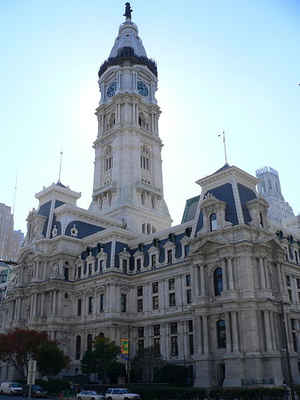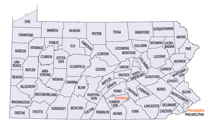Philadelphia County, Pennsylvania
Philadelphia County Education, Geography, and History

Philadelphia County is a county located in the commonwealth of Pennsylvania. Based on the 2010 census, the population was 1,526,006, making it the
most populous county in the state, despite being the second smallest county in the state by land area. Philadelphia County is one of the three
original counties, along with Chester and Bucks counties, created by William Penn in November 1682. Since 1854, the county has been
coterminous with the city of Philadelphia, which also serves as its seat. It is the most populous county in the United States coterminous with
a municipality.
Philadelphia County is the heart of the Philadelphia-Camden-Wilmington, PA-NJ-DE-MD (Delaware Valley) Metropolitan Statistical Area.
Etymology - Origin of Philadelphia County Name
One of the three original counties created by William Penn in November 1682, and its name to him signified "brotherly love," although the original Philadelphia in Asia Minor was actually "the city of Philadelphus."
Demographics:
County QuickFacts: CensusBureau Quick Facts
Philadelphia County History
One of the three original counties
created by William Penn in November 1682, and its name to him signified
"brotherly love," although the original Philadelphia in Asia Minor was actually
"the city of Philadelphus." Philadelphia was laid out in 1682 as the county seat
and the capital of the Province; it was chartered as a city on October 25, 1701,
and rechartered on March 11, 1789. On February 2, 1854, all municipalities
within the county were consolidated with the city. The county offices were
merged with the city government in 1952.
Swedes and Finns first settled within the county in 1638. Dutch seized the area
in 1655, but permanently lost control to England in 1674. Penn's charter for
Pennsylvania was received from the English king in 1681, and was followed by
Penn's November 1682 division of Pennsylvania into three counties. The City of
Philadelphia merged (and became synonymous) with Philadelphia County in 1854.
Thomas Holme made the physical plan for the City, and the Northern Liberties
were designated to give urban lots to all who purchased 5,000 rural acres in
Pennsylvania. The City had eighty families in 1683, 4,500 inhabitants in 1699,
10,000 in 1720, 23,700 in 1774. Philadelphia was economically the strongest city
in America until surpassed by New York City in population in 1820 and in
commerce by about 1830, although Philadelphia was strongest in manufacturing
until the early twentieth century. It led the nation in textiles, shoes,
shipbuilding, locomotives, and machinery. Leadership in transportation, both as
a depot and a center for capital funding, was another Philadelphia attribute.
This was readily apparent as the Pennsylvania Railroad grew to be a nationwide
system. Quaker leadership, which had shaped the pre-Revolutionary culture,
gradually gave way. Both the numbers and the wealth of the Society of Friends
shrank. Before the Civil War, race riots and nativists' anti-Catholicism
erupted. A strong African American community existed by the early nineteenth
century, but abolitionists met stiff popular resistance. After the Civil War,
the central business district of today emerged. Large retail sales stores arose
in center city, and suburbs grew, delineated by race, income, and ethnicity.
Three decades of urban renewal occurred after World War II. Reform mayors Joseph
Clark and Richardson Dilworth allied themselves with the urban renewal cause.
The Federal Housing Act of 1954 used Philadelphia's system as a model for
low-income housing. In 1953 the Broad Street Railroad Station and the elevated
"Chinese Wall" were torn down to be replaced by John F. Kennedy Boulevard and
the Penn Center.
The Philadelphia Industrial Development Corporation was initiated in 1958. Much
restoration of the oldest areas, especially east of City Hall, was accomplished.
Philadelphia once had a reputation as the "private city," in the sense that
activities of the family and in the home had a social priority. There is a
noticeably strong African American culture. The city has a large medical complex
that rivals Boston and New York. It also has an old professional baseball
tradition. The venerable University of Pennsylvania's folk "gladly learn and
gladly teach," and art, music, and museums flourish.
Geography: Land and Water
As reported by the Census Bureau, the county has a total area of 142.6 square miles (369.4 km2), of which, 135.1 square miles (349.9 km2) of it is land and 7.6 square miles (19.6 km2) of it is water. The total area is 5.29% water. Bodies of water include the Delaware River, Schuylkill River, Cobbs Creek, Wissahickon Creek, and Pennypack Creek.
Neighboring Counties
Bordering counties are as follows:
- Montgomery County, Pennsylvania (north)
- Bucks County, Pennsylvania (northeast)
- Burlington County, New Jersey (east)
- Camden County, New Jersey (southeast)
- Gloucester County, New Jersey (south)
- Delaware County, Pennsylvania (west)
Education







